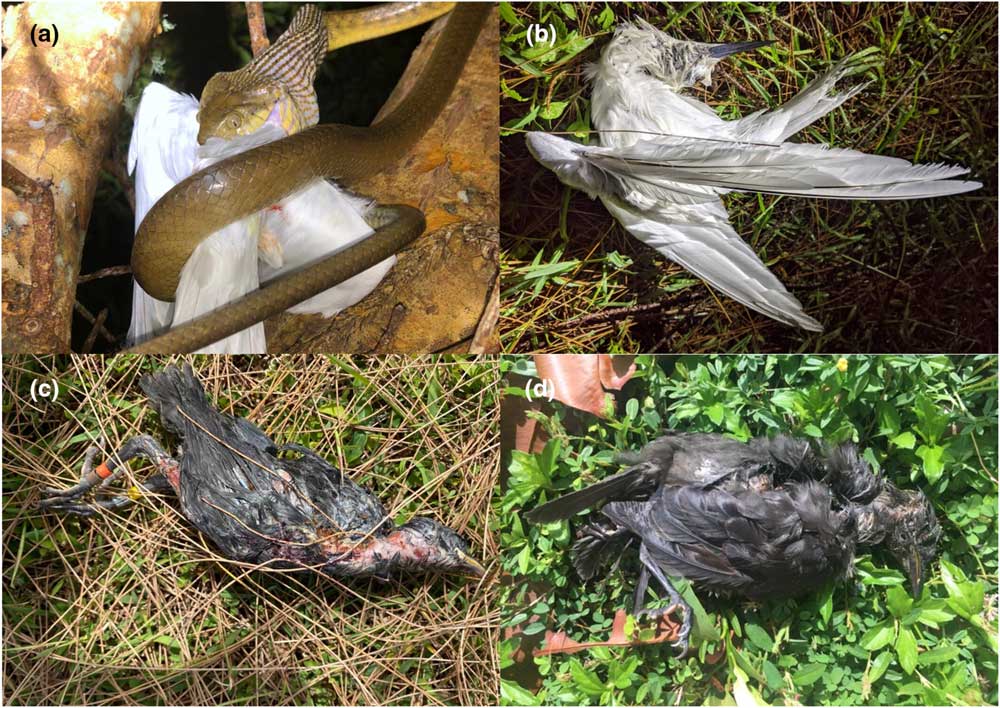The brown tree snake has caused all sorts of problems on Guam. In addition to effectively changing that island’s ecology, the snake has caused power failures and efforts to eradicate it have cost millions of dollars.
The invasive brown tree snake (Boiga irregularis) on Guam, which were introduced onto the island sometime during or after World War 2, have decimated that island nation’s bird population. And now, new research shows that these colubrids are killing birds that are too large for them to ingest.
Researchers with the U.S. Geological Survey Pacific Island Ecosystems Research Center on Hawaii, United Stated Department of Agriculture National Wildlife Research Center on Guam, and the Department of Fish and Wildlife Conservation, Virginia Tech studied the brown tree snake on Guam between November 2019 and October 2022 and its interaction with the Såli or the Micronesian Starling on the Andersen Air Force Base (AAFB) on the northern tip of the island. The airforce base is 8,100 hectares. The brown tree snake is a major predator of the Såli.
Brown Tree Snake’s Lasso Locomotion Helps It Climb Trees To Eat Birds On Guam
The researchers tagged fledgling Såli with radio transmitters and assigned the cause of mortality when they found dead radio tagged fledglings, fledglings ingested and inside a snake, gut passed by the snake, and killed but unsuccessfully ingested by the snake, which the researchers referred to as ‘slimed.” The researchers found that only the brown tree snake predator would leave a saliva coating on bird’s head and body after a failed ingestion attempt. The researchers also hand captured snakes that had consumed a radio tagged fledgling during the daily survival checks of these birds.

(a) Large Brown Treesnake (Boiga irregularis) in the process of ingesting a CHunge’ (White Tern, Gygis candida; photo credit: Nathan Sablan, public domain); (b) slimed (unsuccessfully ingested) adult CHunge’ found incidentally; (c) slimed fledgling Såli (Micronesian Starling, Aplonis opaca) found during telemetry work; and (d) slimed Såli adult found incidentally. Source: “Gape-limited invasive predator frequently kills avian prey that are too large to swallow.” Ecology and Evolution
“We recorded 294 Såli fledgling mortalities out of 461 fledglings tracked, of which 171 (58%) were attributed to BTS, and 89 (30%) to cats, the researchers wrote in their paper. “Among BTS-caused mortalities, 82 fledglings (48%) were slimed but not ingested by BTS and 89 (52%) were ingested. Two of the slimed fledglings had been scavenged by cats, but their mucus-coated heads were present among the remains, allowing us to determine their primary cause of death. For the other mortalities attributed to cats, we were unable to differentiate between direct kills and scavenging events because there were insufficient carcass remains to allow a definitive determination.”

Records (n = 294 total) of Såli (Micronesian Starling, Aplonis opaca) fledgling mortalities from Andersen Air Force Base, Guam, monitored via radio-telemetry between November 2019 and September 2022, by cause of mortality. BTS, Brown Treesnake (Boiga irregularis). Mortalities caused by unsuccessful ingestion by BTS (“slimed”, n = 82) are shaded white, all other categories are shaded gray. Mortalities identified as cat predation may represent direct kills or scavenging events. Other causes of mortality include starvation, exposure, road mortalities, and entanglement. The “unknown” category represents situations where it was not possible to determine the cause of mortality. Source: “Gape-limited invasive predator frequently kills avian prey that are too large to swallow.” Ecology and Evolution
The researchers note that while just under half of the radio transmitters birds were killed by the snakes and not successfully consumed, it is likely an underestimate as they attribute some of the mortalities that are attributed to feral cats might have first been killed by the snake and unsuccessfully eaten.
The complete paper, “Gape-limited invasive predator frequently kills avian prey that are too large to swallow” can be read on the Ecology and Evolution website.
Brown Tree Snake Information
The brown tree snake has caused all sorts of problems on Guam. In addition to effectively changing that island’s ecology, the snake has caused power failures and efforts to eradicate it have cost millions of dollars. The snake is responsible for the extinction of nine native forest birds on Guam and three lizard species. Other bird species on the island have been significantly impacted by this snake and certain sea bird species no longer nest there. With these birds removed from the ecosystem, the island’s spider populations have gone largely unchecked, according to a study published in the journal PLoS One.
Prior to the introduction of the brown tree snake on Guam, there were ten native birds that were known to eat insects: Bridled White-eye (Zosterops conspicillatus), Rufous Fantail (Rhipidura rufifrons), Micronesian Starling (Aplonis opaca), Mariana Swiftlet (Aerodramus bartschi), Cardinal Honeyeater (Myzomela rubratra), Nightingale Reed-Warbler (Acrocephalus luscinia), Mariana Crow (Corvus kubaryi), Micronesian Kingfisher (Todiramphus cinnamominus), Guam Flycatcher (Myiagra freycineti), and the Guam Rail (Gallirallus owstoni).
The snake is a nocturnal, rear fanged venomous species of the family Colubridae. It is native to northern Australia, New Guinea, and the Solomon Islands. It averages two to four feet in length, with the largest specimen captured on Guam measuring 10 feet. It feeds on lizards, rats, birds, shrews, and other small animals.


